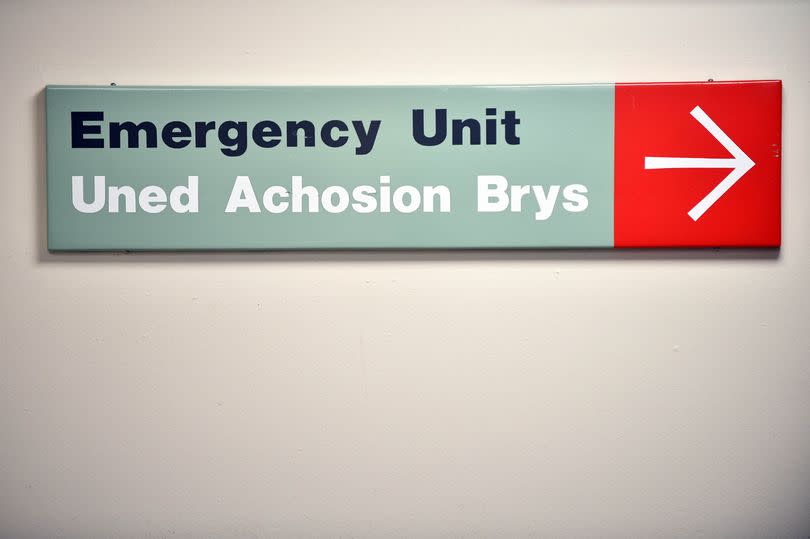The number of people waiting for treatment on the NHS in Wales has hit a record high

More people are waiting for healthcare treatment in Wales than ever before, new figures have shown. NHS data released by the Welsh Government showed rises in the number of people on waiting lists, longer waits in A&E, fewer cancer patients starting treatment within the two-month target and ambulances taking longer to get to the most urgent calls.
The figures released on Thursday show winter pressures and strike disruption have been extremely disruptive for the NHS. There were around 591,600 individual patients on waiting lists for treatment in Wales in February, which is the highest number ever recorded.
The number of open patient pathways - which is a higher figure as some people are waiting for more than one type of treatment - increased from just over 754,800 to just over 763,100 in the months between January and February. For the latest health and Covid news, sign up to our newsletter here
READ MORE: 'I'm still alive 15 years after cancer diagnosis - this saved my life and could save yours too'
In March, the average time people spent waiting in emergency departments increased compared to the previous month to two hours and 47 minutes. The number of people who waited more than 12 hours to be admitted, transferred or discharged also increased that month, with 10,366 patients waiting 12 hours or more. Betsi Cadwaldr UHB was the health board area with the most patients waiting this long, while Cardiff and Vale UHB was the area with the fewest people waiting more than 12 hours.
Cabinet secretary for health, Eluned Morgan, said she was disappointed to see that long stays in emergency departments had increased, she added: "I expect health boards to renew their focus on reducing long stays in emergency departments, particularly for frail and older people."
She also said that there was "still a lot of work to do to improve waiting times and NHS performance", and added that "some health boards need to do better." Ms Morgan said the increase in the overall waiting times was "not surprising as we saw strike action in February." Join our WhatsApp news community here for the latest breaking news
Key points from the data:
In March, just under 94,900 calls were made to the 111 helpline service, an increase of around 17,100 calls compared to the previous month. Of these, just over 75,600 calls (79.7%) were answered, the second highest figure on record.
In March there were 4,932 red (life threatening) calls to the ambulance service, 13.9% of all calls.
48.9% of red calls received an emergency response within eight minutes. This was 1.0 percentage points lower than in February.
There was an average of 2,962 daily attendances to emergency departments, an increase compared to the previous month.
The average (median) time spent in emergency departments increased in March compared to the previous month to two hours and forty seven minutes.
The number of patient pathways waiting to start treatment increased from just over 754,800 to just over 763,100 in February, the second highest figure on record. One individual can represent multiple patient pathways as patient pathways represent each treatment and not just the individual patient.
Management numbers suggest that there are 591,600 individuals waiting for treatment, as of February.
The proportion of patient pathways waiting less than 26 weeks increased to 56.6% in February.
The number of pathways waiting longer than 36 weeks increased in February, to just over 244,600, remaining high in historical context.
Just under 23,000 pathways were waiting more than two years, over two thirds (67.4%) lower than the peak and continuing to fall month on month.
The average time people spent waiting for treatment by February was 21.3 weeks.
The number of people who started their cancer treatment within the 62 day target in February decreased to 53.4% compared to 54.7% the month before - the second lowest percentage ever recorded
The response
Glenn Page, Policy and Public Affairs Manager at Macmillan Cancer Support, said of the cancer treatment waiting times: "This can't go on."
He said: “This is one of the worst performances on record. That is why improving cancer treatment waiting times and reducing waiting lists is now set to become a true litmus test of the leadership provided by Wales’ new First Minister.
“Hardworking healthcare professionals in Wales are running on empty, doing everything they can in a system that needs urgent reform. This can’t go on. It’s time the Welsh government made good on the promises of its Cancer Improvement Plan by delivering real change and improvement within cancer care."
Professor Jon Barry, Director in Wales at the Royal College of Surgeons of England, said it should be a "top priority" to get the waiting lists down. He said: "“It’s encouraging to hear that the new First Minister, Vaughan Gething, is making cutting waiting times his top priority. However, with waiting times on the rise again, we need investment in staff and in surgical hubs sooner rather than later.
“This will help cut waiting lists at the rate that is needed – particularly for those patients who have been waiting the longest. We are only a year away from the Welsh government’s ambition to eliminate waits longer than one year in most areas of surgery. This must be top priority. Patients waiting more than one or even two years for treatment will be suffering huge disruption to their lives and there is a risk that their condition will deteriorate while they wait. We can’t allow this to become the “new normal” for planned operations in Wales.”

 Yahoo News
Yahoo News 
